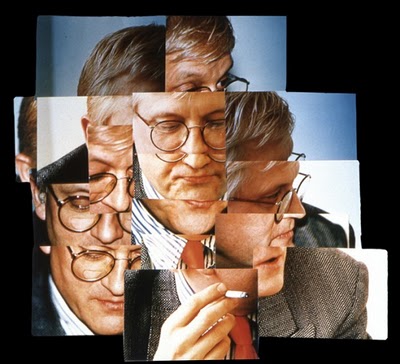All the Lawrence Weschler books I’ve read—Vermeer in Bosnia, Mr. Wilson’s Cabinet of Wonder, Seeing Is Forgetting the Name of the Thing One Sees and A Wanderer in the Perfect City—are wonderful, difficult, surprising and unique. The same can be said of his new Smithsonian article about artist David Hockney’s relationship with technology and optical techniques. An excerpt:
“As I say, despite his critique of the optical look created by early technologies, a striking openness to new technologies has long been a feature of Hockney’s career. There was a time when the people at Canon photocopiers used to ply him with experimental cartridges, long before they went to market, just to see what he’d come up with. (He came up with a suite of ‘handmade prints.’) Likewise fax machines in the time of their impending ubiquity, and the long-distance, widely broadcast collages he managed to wrest out of those. For that matter, he was one of the first people I knew who had tape and then CD players installed in his cars—the better to choreograph elaborately pre-scored drives through the Santa Monica and San Gabriel mountains, soaring and swooping hours-long affairs, alternating between composers, that almost invariably culminated as one came hurtling over the last pass heading back toward the coast, Wagner at full throttle, with a transcendent vantage of the setting sun just as it went slipping into the sea.
Now it was the turn of the iPhone, whose dazzling potential as a color drawing device, by way of its Brushes application, Hockney was one of the first artists fully to exploit. He’d spend hours noodling around on its touchscreen, and further hours away from the phone itself, just thinking about how he might achieve certain effects: the effect of white porcelain, for example, or cut glass or polished brass; the effect of cut flowers or bonsai or cacti; the effect of the morning sun rising slowly over the sea. This last challenge proved especially engrossing for Hockney. An inveterate chronicler of California sunsets, he’d long wanted to introduce sunrises into his repertory, but had never been able to do so, since it was always too dark to make out the paints and colored pencils, and when he turned on an indoor light to see them, he’d drown out the dawn. But since with the iPhone light itself was the very medium, this was no longer a problem; he could chronicle the most subtle transitions starting out from the pitchest dark. Suddenly his friends all around the world began receiving two, three, or four such drawings a day on their iPhones—each of the incoming dispatches, incidentally, “originals,” since there were no other versions that were digitally more complete. ‘People from the village,’ he told me one day, ‘come up and tease me, ‘We hear you’ve started drawing on your telephone.’ And I tell them, ‘Well, no, actually, it’s just that occasionally I speak on my sketch pad.’ And indeed, the iPhone was proving a much more compact and convenient version of the sorts of sketchbooks he always used to carry around in his jacket pockets, and a less messy one at that (notwithstanding which, each time he slid the phone back into his pocket, he’d rub his thumb and forefinger up against his trousers, by force of habit, wiping off all that digital smudge).
From the iPhone he graduated to the iPad; and from interiors of cut-flower bouquets or the morning view out his window over the dawn-spreading sea, he moved on to more elaborate plein-air studies of the Bridlington environs of the kind he’d already been painting on canvas. In particular, there was an extended suite, comprising 51 separate digital drawings titled The Arrival of Spring in Woldgate, East Yorkshire in 2011 (twenty eleven). Later that fall, back in California for a visit, he launched a perhaps even more evocative iPad investigation of Yosemite Valley—wider vistas in a narrower frame.
At the same time he and his team began exploring the limits of technological capability when it came to transferring digital drawings onto paper—the crisper the image and greater the surface, the better. The resulting wall-size prints held up exceptionally well and soon became an integral feature of the exhibitions surveying this Yorkshire period of Hockney’s lifework.”

